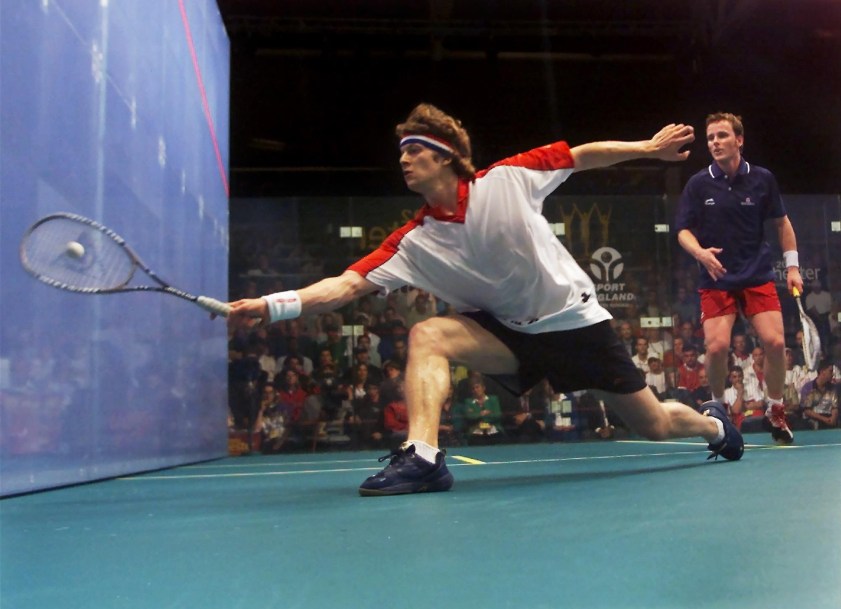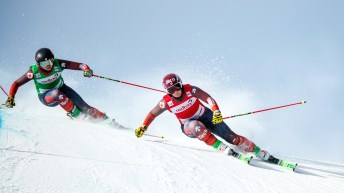Squash Looking to Stay on Top
Jonathon Power, left, (Montreal, Que.) displays his gold medal-winning form against Peter Nicol of England in the squash final at the Commonwealth Games in Manchester, England. Power is the former number one-ranked player in the world.
With the XVI Pan American Games coming up this October, a unique group of teams will represent Canada in Guadalajara, Mexico. All summer long, we profile the nine sports in which Canada competes only at the Pan American Games.
Forget being contenders. One of Canada’s best Pan American teams is on top of the world.
Over four Pan Am Games since its debut, Canadians have been the kings and queens of the squash court. The team has won a total of 23 medals since 1995 – the most of any country. And it’s a run of success that Squash Canada feels isn’t a coincidence.
“We’ve had the number one player in the world, Jonathon Power, who retired a few years ago and we had Graham Ryding who was eighth in the world, also a very strong player,” said Danny Da Costa, Executive Director at Squash Canada. “We continually have developed players that have been competitive on the world stage.”
The keys to the players’ success have come on two fronts. Internally, Squash Canada has routinely funded their athletes to attend tournaments around the world – from junior competitions to world championships, as well as the Commonwealth Games.
But despite these annual efforts, the more significant factor in player development has actually been initiated by the athletes themselves. Many of Canada’s squash players have come through the club system, often training and refining their game together under the same roof for several years. The clubs, which have allowed players to routinely work out in a familiar setting and be mentored, have resulted in not only medals, but for some, a climb up the world rankings.
“When you cluster or have a group of athletes that train together, it’s really beneficial,” said Da Costa. “They’re not scattered across the country. We’re actually starting to see athletes move from other parts of Canada to train (together). That’s one of the strengths of always building a synergy within a club, because the kids and the pros, they feel attached to their club and their members really embrace them.”
Whether at the club or on the court for Canada, the game of squash is similar in nature to tennis, except that it is played within an enclosed area. Players compete on a squash court, which contains walls on three sides and a glass door. The wall directly in front contains three lines; an upper, lower and centre one. The centre line is known as the Service Line, in which players must serve the ball between it and the top line, which is called the Out Line.
Following the serve, players take turns hitting the ball on any of the walls. If the ball hits above the Out Line, below the lower line, known as the Tin, or bounces twice on the floor, the rally is over and a point is awarded. The winner is declared when one player has 11 points, unless the game reaches a score of 10-10. In this situation, players continue until one individual has two more points than his or her opponent.
“At a high level it’s a very strategic, very dynamic game,” explained Da Costa. “They call it ‘chess in a court’ since it requires a lot of tactics. One missed shot or a tactic not being executed will probably make you now have to run around the court to try to regain control of the point.”
The competition at the Pan Am Games consists of a singles event, a team event, and newly-added this year, also a doubles event. The singles and doubles consist of a draw, where eight players or pairs begin in the quarterfinals, and play a three-round best-of-five knockout format. The team event, on the other hand, is a country versus country round-robin showdown, followed by playoffs. It’s also a much longer competition, which can have an effect on the performance of the players.
“The pros are familiar with the draw format because squash is largely an individual game,” said Da Costa. “The difference is, it’s sort of a marathon, because there’s a lot of squash that’s played in a short amount of time. They have to go right from the single event, into the doubles, right into the team event, and that’s an adjustment. Normally (during the year), they prepare for just a singles tournament. To win a tournament, you might have to win four or five matches. Here, they might be playing 10 or 12.”
Currently, Squash Canada plans on sending six individuals to compete in Mexico – three men and three women, all at the top of the Canadian rankings. The men’s list includes Toronto native and four-time National champion Shahier Razik, Montreal’s Shawn Delierre and Andrew McDougall of Calgary. Razik and Delierre – who have both been in the top 40 rankings in the world – return from the 2007 team that won a silver medal in the team event and a bronze in singles. McDougall, meanwhile, is an up-and-coming player in the Canadian system, looking to make some noise this fall.
The women’s roster isn’t as deep, featuring an entirely new trio than the one that competed four years ago in Rio de Janeiro. Heading to Guadalajara will be National champion Miranda Ranieri and Stephanie Edmison of Toronto, and Ottawa’s Samantha Cornett. Ranieri honed her game in the U.S. College system – playing in the National Collegiate Athletic Association (NCAA), while Edmison is one of world’s best in doubles.
As the Pan Am Games draw closer, Canada’s athletes have the challenge of keeping their country on top of the all-time podium. But with a revamped roster this year, the task may not be as easy as in the past.
“We were fortunate to have a golden era of great squash players,” said Da Costa. “We’re in a little bit of a transition but we still feel that we have players that are capable of medalling and continuing the legacy that we’ve built at the Pan American level. It’s tough, (because) everyone in the world is getting better.”




